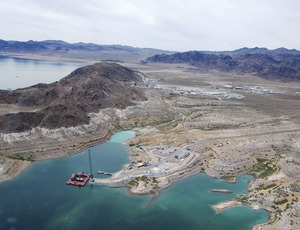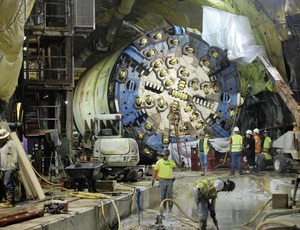

A construction accident at the four-year-old raw-water intake project at southern Nevada's Lake Mead, now a $526.6-million job, claimed its first fatality on June 11, when Thomas A. Turner, a union laborer and operating engineer, was struck in the head by a 200-psi jet stream of grout that included fist-sized rocks. Tunneling remained shut down at ENR press time on June 19.
The 44-year-old worker was securing a 20-ft-dia concrete ring, comprising six 17-ton precast segments, when one of the 20-ft-long segments jarred loose, opening a 4-in. by 2-ft gap. About 13.5 cu ft of grout shot through the opening, killing Turner and injuring another worker. A member of operating engineers' Local 12 and laborers' Local 872, Turner was in a 12-man crew working 600 ft underground when the accident occurred. His brother, Paul, also works on the project.
The project calls for installing 2,500 segments, which are lifted into place with a crane, then secured by rock bolts and a concrete slurry grout; compressive stress does the rest. The incident is being investigated by the Nevada Occupational Safety and Health Administration, which has done eight site inspections since August 2008. The project has accumulated 14 safety violations, says the U.S. Labor Dept., although most were disputed or dismissed. There will be about 250 workers on-site during construction peak, says Jim McDonald, project manager with design-build contractor Vegas Tunnel Constructors LLC (VTC), a joint venture of S.A. Healy Co. and Italy's Impreglio S.p.A. "This is a difficult time for our organization, the contractor and the crew," owner Southern Nevada Water Authority said in a statement.
The fatality is the latest setback for the project. Costs have risen 15% from its original $447 million. The authority approved a $39.5-million change order in February. Prior to the accident, the project was about 20 months behind its schedule. VTC encountered water three times in six months while creating a starter tunnel for a three-mile-long intake that will draw water more deeply from Lake Mead because its surface level has fallen about 100 ft since 2000. The drop threatens to shutter Hoover Dam's hydroelectric turbines by 2013. Marc Jensen, the authority's director of engineering, says the project is "insurance in case our current intakes become inoperable" and will boost the quality of water drawn.
Water seepage first occurred on June 28, 2010, filling a 200-ft-long, 37-ft-high staging vault and ruining some mining equipment. The joint-venture team, which includes geotechnical consultants Brierley Associates LLC and Arup, spent months pumping out water and stabilizing rock fractures with grout in hopes of preventing another incident. Although another mishap occurred, a ready-and-waiting emergency bulkhead prevented cavern re-flooding. A third small water breach occurred after Christmas in 2010.
VTC opted to drill in a drier direction by moving roughly 20° east from the 28-ft-dia, 200-ft-long horseshoe-shaped starter tunnel; the new tunnel rejoins the original alignment. The project uses a German-made, $25-million custom tunnel-boring machine. The 1,500-ton, 600-ft-long mega-machine operates in both open and closed modes, meaning the drill face is pressurized for more efficient ground and water control, McDonald says.
The TBM will remove 260,000 cu yd of material, most of which will be recycled and used to shield construction from public view. After some trial and error, VTC has installed 133 concrete rings for about 1,000 ft of tunnel. But the 1,571-day project schedule still carries millions of dollars in potential liquidated damages.

Post a comment to this article
Report Abusive Comment